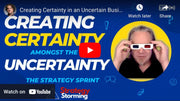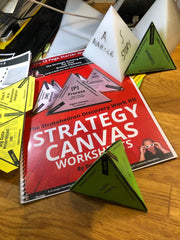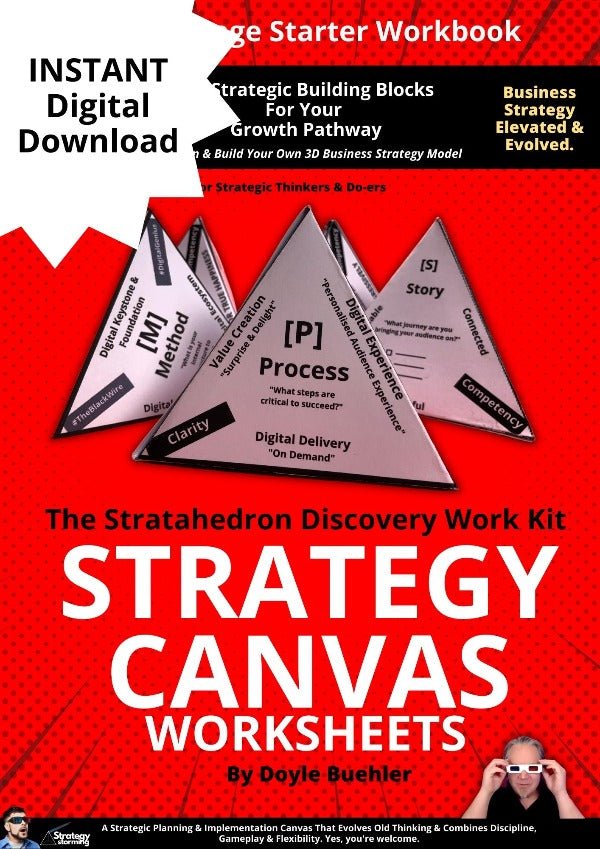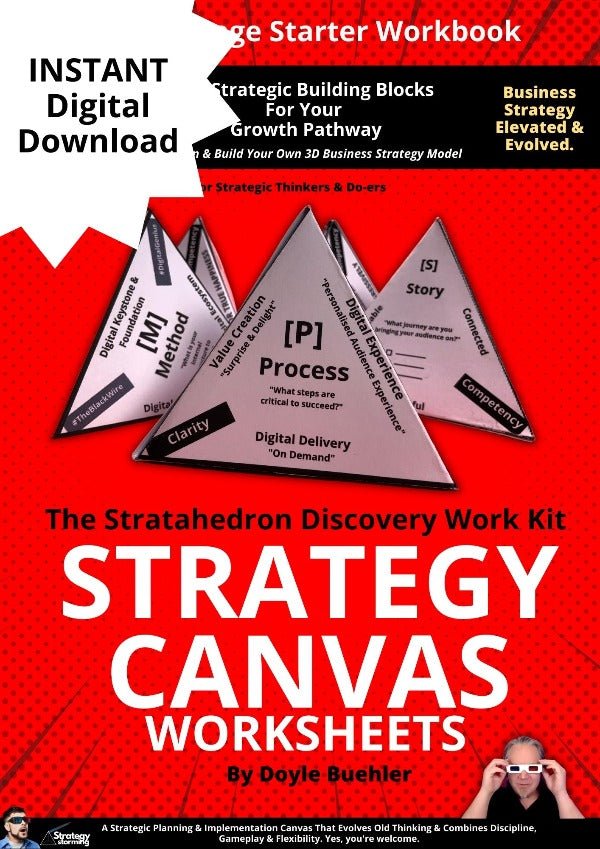Is it the annual strategy planning PANIC season time AGAIN? Do you zig or do you prefer to zag with your strategic planning?
The strategic planning season is upon us. As businesses, we often find ourselves caught in the cyclical zig-zag pattern of planning, reacting to the calendar rather than proactively shaping our strategic direction. But what if there was a better way? A structured, comprehensive approach that not only breaks the cycle but also ensures long-term success?
The Zig-Zag Dilemma
Oh no, it's that time of the year again! The Google Trends data reveals a peculiar trend: businesses often prioritize strategic planning during two specific times of the year. The first surge comes in January and February, as companies scramble to draft a plan for the new year. The second wave hits in August and September, a last-ditch effort to salvage the year after realizing that little has changed over the past eight months.
Take a look at what we are searching for, in our quest for strategic planning from Mother Google

Take a look at what the Google Trends Data Is telling you, here.
The data tells a completely different story.
Most get anxious about it at two specific times a year:
But why this cyclical pattern? Conventional wisdom suggests it's because businesses are gearing up for the next year, perhaps driven by budget approvals. This reactive approach often results in hastily cobbled-together plans, using generic templates downloaded from the internet. These plans, though well-intentioned, are often shelved come January, only to be revisited the following year with a sense of déjà vu.
Navigating the Zig-Zag of Strategic Planning: A Four-Part Guide
In the ever-evolving world of business, many organizations find themselves caught in the "zig-zag" approach to strategic planning. This pattern, characterized by reactive, sporadic bursts of planning often driven by the calendar rather than genuine strategic need, can lead to wasted resources, missed opportunities, and a lack of long-term vision. While it's tempting to rush into strategy during perceived "peak" times, this cyclical, back-and-forth method often lacks consistency and foresight, leaving businesses ill-prepared for future challenges and opportunities.
Here's how we can break out of that ineffective pattern of strategic planning.
1. Recognizing the Zig-Zag Pattern
- Historical Trends: Understanding the common times of the year when businesses typically rush to strategize.
- The Pitfalls of Panic Planning: Identifying the drawbacks of reactive, last-minute strategic planning.
- Data-Driven Insights: Using tools like Google Trends to visualize the cyclical nature of strategic planning interest.
- The Cost of Conformity: Realizing that merely following the crowd can lead to wasted resources and missed opportunities.
2. Breaking the Cycle
- Proactive Planning: Emphasizing the importance of continuous, year-round strategic thinking.
- Vision Over Reaction: Prioritizing long-term goals over short-term, reactionary measures.
- Embracing Change: Understanding that adaptability and flexibility are key to breaking the zig-zag pattern.
- Mindset Shift: Cultivating a mindset that sees beyond the calendar months and focuses on the bigger picture.
3. Tools & Resources for Effective Strategy
- Strategic Success Blueprint: Leveraging comprehensive checklists to ensure a holistic approach to planning.
- Digital Platforms: Utilizing tools like StratNavApp.com to transform static plans into dynamic, evolving strategies.
- Training & Workshops: Investing in programs like the Strategystorming VIP Strategy Day to refine strategic skills.
- Resource Library: Accessing worksheets and resources on platforms like strategystorming.co to enhance strategic capabilities.
4. The Road Ahead: Beyond Zig-Zag
- Commitment to Consistency: Ensuring that strategic planning becomes a regular, consistent activity.
- Celebrating Milestones: Recognizing and rewarding progress to boost morale and maintain momentum.
- Continuous Learning: Staying updated with the latest in strategic planning methodologies and best practices.
- Collaboration & Feedback: Engaging stakeholders, team members, and experts for a more rounded, effective strategy.
By understanding and addressing these four areas, businesses can navigate the common pitfalls of the zig-zag approach to strategic planning, ensuring a more consistent, effective, and forward-thinking strategy.
Failures of Traditional Strategic Planning
Traditional strategic planning often fails due to several reasons:
Pathways Forward:
Action Plan for Effective Strategic Planning:
Before Starting on Your Strategic Plan:
-
SWOT Analysis: Identify your business's Strengths, Weaknesses, Opportunities, and Threats.
-
Stakeholder Analysis: Understand who your primary stakeholders are and what they expect from your business.
-
Resource Inventory: List out all the resources (both tangible and intangible) at your disposal.
-
Market Analysis: Understand your target audience, competitors, and market trends.
Creating the Strategic Plan:
-
Vision and Mission Statement: Clearly define what you aim to achieve in the long run and how you plan to do it.
-
Set Clear Objectives: Break down your vision into smaller, achievable objectives.
-
Strategy Formulation: Use the Strategy SuperModels to create a structured approach. This will help in aligning your objectives with actionable strategies.
-
Budget Allocation: Ensure you have a clear budget for each strategy, ensuring optimal resource allocation.
Post-Completion of the Strategic Plan:
-
Implementation: A plan is only as good as its execution. Ensure that every team member understands their role and responsibilities.
-
Monitoring and Control: Regularly track the progress of your strategies. Use the tools available on strategystorming.co for effective monitoring.
-
Feedback Mechanism: Create a system where team members can provide feedback on the strategies implemented.
-
Regular Updates: The business environment is dynamic. Ensure that your strategic plan is flexible enough to accommodate changes.
Additional Resources:
Strategystorming.co offers a plethora of resources to aid in your strategic planning journey:
-
Worksheets: Detailed worksheets that guide you through every step of the strategic planning process.
-
Strategy SuperModels: Comprehensive models that provide structure and alignment to your strategic plan.
-
Training Modules: In-depth training sessions that cover various aspects of strategic planning.
Strategic planning is not just a once-a-year activity but a continuous process that requires structure, alignment, and regular monitoring. With the right tools, training, and mindset, you can break free from the zig-zag cycle and set your business on the path to long-term success with Strategy.
Additional Strategic Planning Resources
Where to go for more Strategic Planning Resources?
Take a look at the Strategic Planning VIP Private Workshop Package
Open up the Strategic Planning Checklist to ensure that you have everything you need for strategic planning.
Download your Free SWOT Strategic Planning Designer PDF (Strengths, Weaknesses, Opportunities, Threats)
Find out now how Can You Use SWOT For Your Business.
Grab your free SWOT 1-Page Designer PDF for Free.


![The Entrepreneur Journey is Broken? [Part 1] - Strategystorming - The Strategy Studio & Shop for Strategic Thinkers](http://strategystorming.co/cdn/shop/articles/the-entrepreneur-journey-is-broken-part-1-590109.webp?v=1701206679&width=180)












































![#SmartStrategy [Designing Your Strategy For Business] - Strategystorming - The Strategy Studio & Shop for Strategic Thinkers](http://strategystorming.co/cdn/shop/articles/smartstrategy-designing-your-strategy-for-business-256943.jpg?v=1693515536&width=180)





